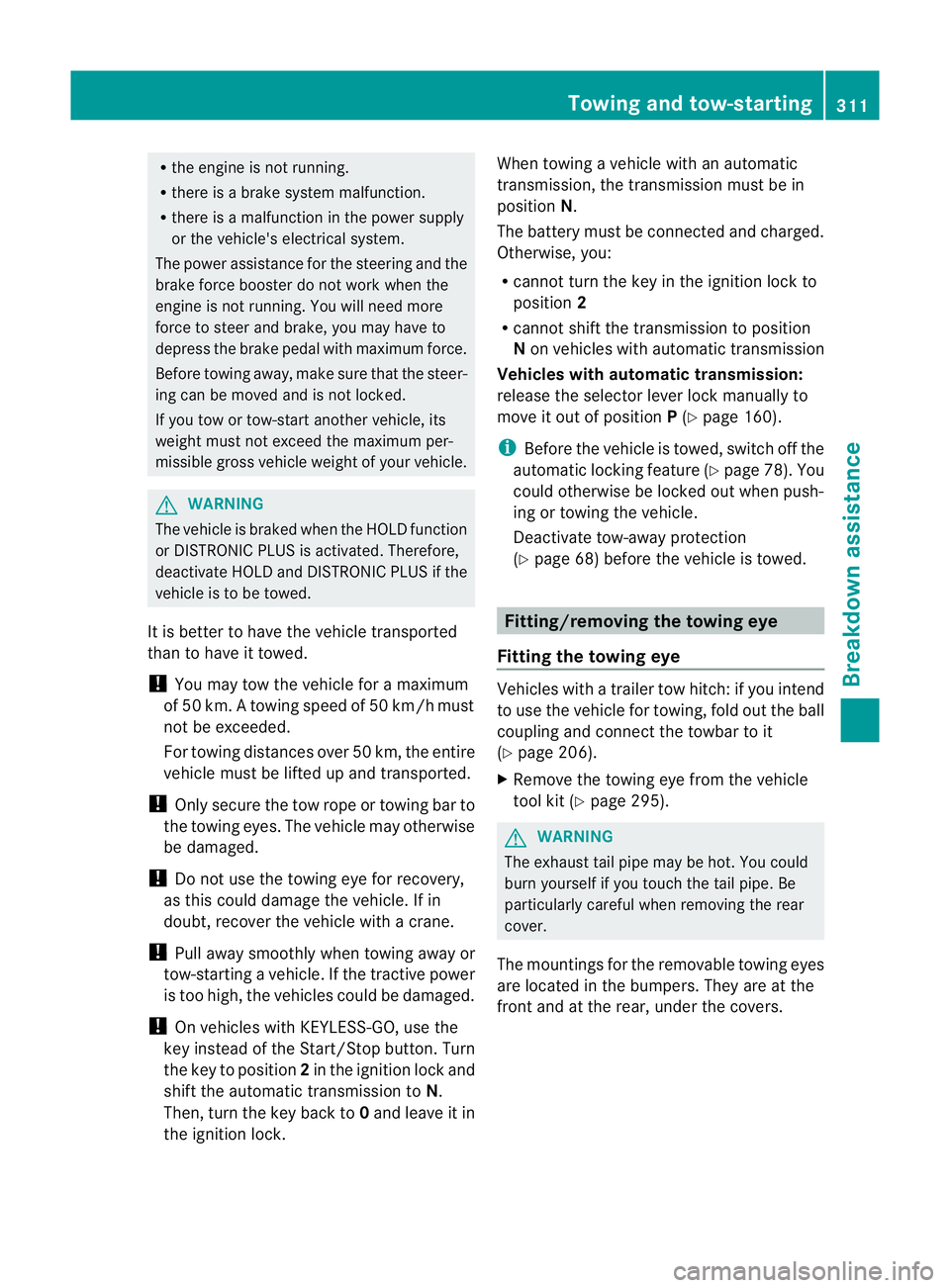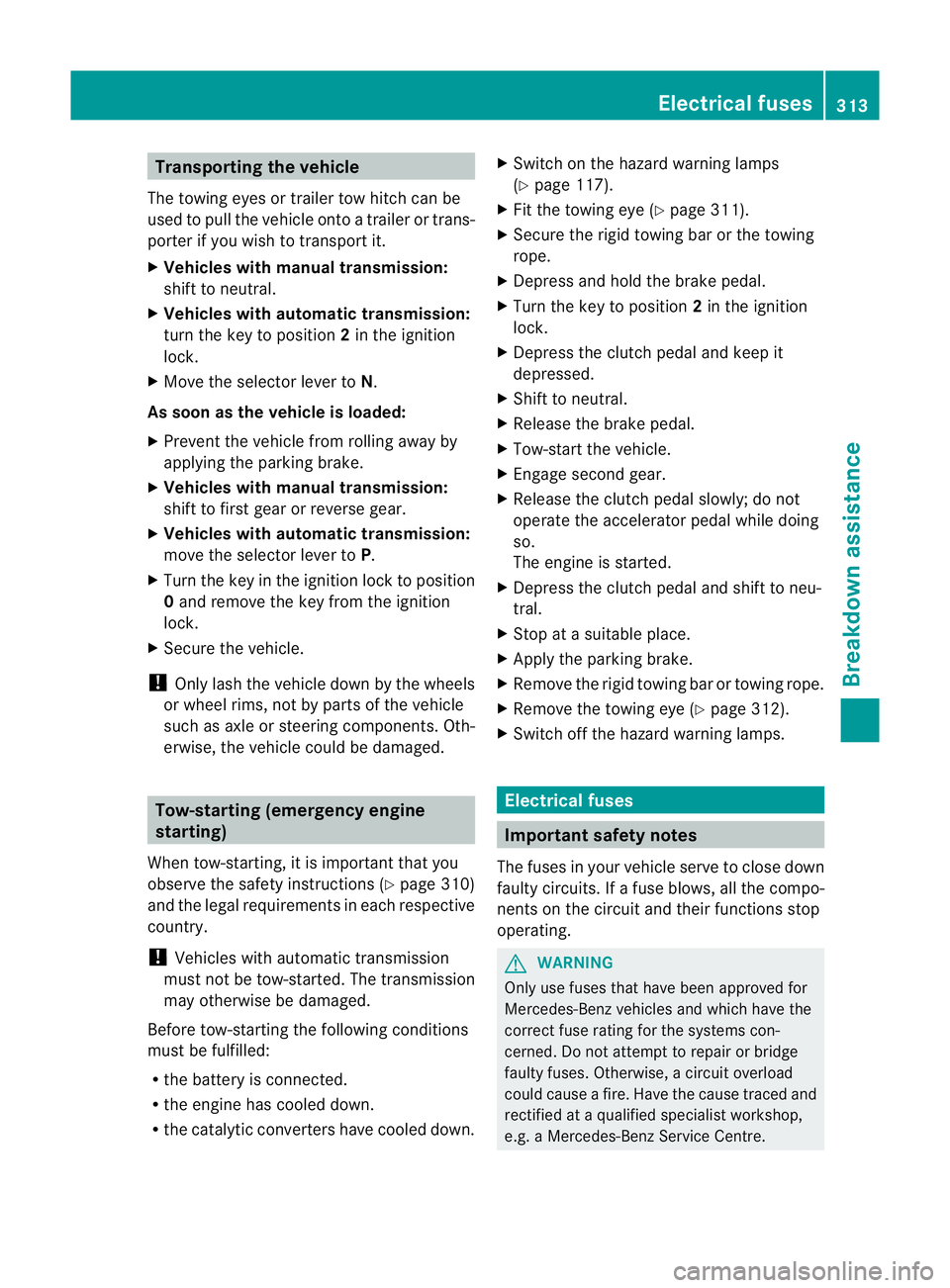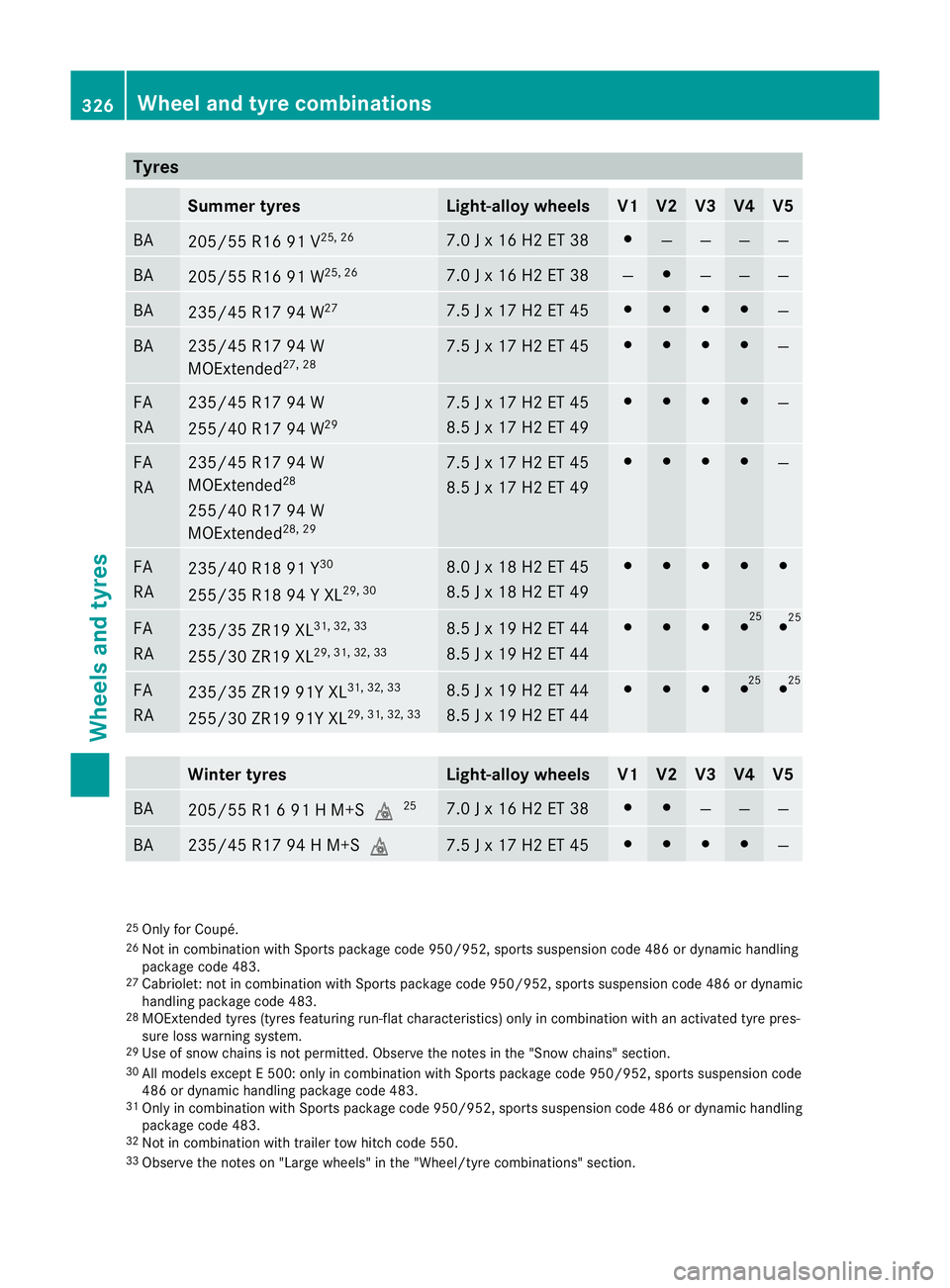2011 MERCEDES-BENZ E-CLASS CABRIOLET trailer
[x] Cancel search: trailerPage 314 of 353

R
the engine is not running.
R there is abrake syste mmalfunction.
R there is amalfunctio ninthe power supply
or the vehicle's electrical system.
The power assistance for the steering and the
brake force booster do not work when the
engine is not running. You will need more
force to steer and brake, you may have to
depress the brake pedal with maximum force.
Before towing away,m ake sure that the steer-
ing can be moved and is not locked.
If you tow or tow-start another vehicle, its
weight must not exceed the maximum per-
missible gross vehicle weight of your vehicle. G
WARNING
The vehicle is braked when the HOLD function
or DISTRONIC PLUS is activated. Therefore,
deactivate HOLD and DISTRONIC PLUS if the
vehicle is to be towed.
It is better to have the vehicle transported
than to have it towed.
! You may tow the vehicle for amaximum
of 50 km. Atowing speed of 50 km/h must
not be exceeded.
For towing distances over 50 km, the entire
vehicle must be lifted up and transported.
! Only secure the tow rope or towing bar to
the towing eyes. The vehicle may otherwise
be damaged.
! Do not use the towing eye for recovery,
as this could damage the vehicle. If in
doubt, recover the vehicle with acrane.
! Pull away smoothly when towing away or
tow-starting avehicle. If the tractive power
is too high, the vehicles could be damaged.
! On vehicles with KEYLESS-GO, use the
key instead of the Start/Stop button. Turn
the key to position 2in the ignition lock and
shift the automatic transmission to N.
Then, turn the key back to 0and leave it in
the ignition lock. When towing
avehicle with an automatic
transmission, the transmission must be in
position N.
The battery must be connected and charged.
Otherwise, you:
R cannot turn the key in the ignition lock to
position 2
R cannot shift the transmission to position
N on vehicles with automatic transmission
Vehicles with automatic transmission:
release the selector lever lock manually to
move it out of position P(Y page 160).
i Before the vehicle is towed, switch off the
automatic locking feature (Y page 78). You
could otherwise be locked out when push-
ing or towing the vehicle.
Deactivate tow-away protection
(Y page 68) before the vehicle is towed. Fitting/removing the towing eye
Fitting the towing eye Vehicles with
atrailer tow hitch: if you intend
to use the vehicle for towing, fold out the ball
coupling and connect the towbar to it
(Y page 206).
X Remove the towing eye from the vehicle
tool kit (Y page 295). G
WARNING
The exhaust tail pipe may be hot. You could
burn yourself if you touch the tail pipe. Be
particularly careful when removing the rear
cover.
The mountings for the removable towing eyes
are located in the bumpers. They are at the
front and at the rear, under the covers. Towing and tow-starting
311Breakdown assistance Z
Page 316 of 353

Transporting the vehicle
The towing eyes or trailer tow hitch can be
used to pull the vehicl eonto atrailer or trans-
porter if yo uwishtot ransport it.
X Vehicle swithm anual transmission:
shift to neutral.
X Vehicle switha utomatic transmission:
tur nthe key to position 2in the ignition
lock.
X Move the selector lever to N.
As soon as the vehicle is loaded:
X Prevent the vehicle from rolling away by
applying the parking brake.
X Vehicles with manualt ransmission:
shift to first gear or reverse gear.
X Vehicles with automatic transmission:
move the selector lever to P.
X Turn the key in the ignition lock to position
0 and remove the key from the ignition
lock.
X Secure the vehicle.
! Only lash the vehicle down by the wheels
or wheel rims, not by parts of the vehicle
such as axle or steering components. Oth-
erwise, the vehicle could be damaged. Tow-starting (emergency engine
starting)
When tow-starting, it is important that you
observe the safety instructions (Y page 310)
and the legal requirements in each respective
country.
! Vehicles with automatic transmission
must not be tow-started. The transmission
may otherwise be damaged.
Before tow-starting the following conditions
must be fulfilled:
R the battery is connected.
R the engine has cooled down.
R the catalytic converters have cooled down. X
Switch on the hazard warning lamps
(Y page 117).
X Fit the towing eye (Y page 311).
X Secure the rigid towing bar or the towing
rope.
X Depress and hold the brake pedal.
X Turn the key to position 2in the ignition
lock.
X Depress the clutch pedal and keep it
depressed.
X Shift to neutral.
X Release the brake pedal.
X Tow-start the vehicle.
X Engage second gear.
X Release the clutch pedal slowly;don ot
operate the accelerator pedal while doing
so.
The engine is started.
X Depress the clutch pedal and shift to neu-
tral.
X Stop at asuitable place.
X Apply the parking brake.
X Remove the rigid towing bar or towing rope.
X Remove the towing eye (Y page 312).
X Switch off the hazard warning lamps. Electrical fuses
Important safety notes
The fuses in your vehicle serve to close down
faulty circuits. If afuse blows ,all th ecom po-
nent sont hecircuit and their function sstop
operating. G
WARNING
Only use fuses that have been approve dfor
Mercedes-Ben zvehicles and which have the
correct fuse ratin gfor the systems con-
cerned. Do not attempt to repair or bridge
faulty fuses. Otherwise, acircuit overload
could cause afire. Have the cause traced and
rectified at aqualified specialist workshop,
e.g. aMercedes-Benz Service Centre. Electrical fuses
313Breakdown assistance Z
Page 324 of 353

Tyre pressure
Tyre pressure specifications
Yo uw illf ind atable of tyr epressures for var-
ious operating conditions on the insid eof
your vehicle's fuel fille rflap.
Operation with emergency spare wheel:
The applicable value for the emergency spare
wheel is stated on the spare wheel and in the
technical data section.
Operation with atrailer: The applicable
value for the rear tyre sisthe maximum tyre
pressure value stated on the table insid ethe
fuel filler flap.
The table insid ethe fuel filler flap may state
tyre pressures for differen tload conditions.
These are defined in the table as different
numbers of passengers and amounts of lug-
gage. The actual number of seats may vary –
for more information please refer to the vehi-
cle's registration documents.
If no other data is stated, the tyre pressures
specified on the fuel filler flap apply for all
tyres approved for this vehicle. If
at yre size precedes atyre pressure, the tyre
pressure information following is only valid
for that tyre size. Instead of the complete tyre size, the rim
diameter alone, for example
R16,may be lis-
ted. Rim diameter
:is part of the tyre size and
can be found on the tyre sidewall. G
WARNING
Tyre pressure that is either too high or too low
has anegative effect on the vehicle's driving
safety, which could lead you to cause an acci-
dent. Therefore, you should regularly check
the pressure of all the tyres, particularly prior
to long trips, and correc tthe pressure as nec-
essary.
To test tyre pressure, use asuitable pressure
gauge. The outer appearance of atyre does
not permit any reliablec onclusion about the
tyre pressure. G
WARNING
Do not fit anything else to the tyre valve other
than the standard valve cap. In particular, ret-
rofitted tyre pressure monitors which are
screwed on to the valve may overload it and
cause it to fail. Due to their design, the valve Tyrep
ressure
321Wheels and tyres
Z
Page 325 of 353

is kept open continuously, which may lead to
air loss. G
WARNING
Should the tyre pressure drop repeatedly:
R chec kthe tyre for foreign bodies.
R check whether the wheel is losing air or the
valve is leaking.
R make sure that only avalve cap approved
by Mercedes-Ben zisfitted on the tyre
valve.
Tyre pressures that are too low have anega-
tive effect on vehicle safety, which could lead
you to cause an accident.
If possible, only correct tyre pressures when
the tyres are cold. The tyres are cold when
the vehicle has been parked for at least three
hours or has been driven less than 1.5 km.
Depending on the ambient temperature, the
speed you are driving at and the load on the
tyres, the tyre temperature and thus the tyre
pressure may change by approximately
10 kPa (0.1 bar/1.5 psi) per 10 †. Take this
into account when checking the pressure of
warm tyres and only correct it if it is too low
for the current operating conditions.
Driving with tyre pressure that is too high or
too low can:
R shorten the service life of the tyres
R cause increased tyre damage
R have anegative effect on handling charac-
teristics and thus the driving safety (e.g. by
causing aquaplaning)
i The tyre pressure values given for low
loads are minimum values which offer you
good ride comfort characteristics.
However, you can also use the values given
for higher loads. These are permissible and
will not adversely affect the running of the
vehicle. H
Environmental note
Check the tyre pressure regularly,atl east
every 14 days. Tyrep
ressur eloss warning system
Important safety notes While the vehicle is in motion, the tyre pres-
sure loss warning system monitors the set
tyre pressure using the rotational speed of
the wheels. This enables the system to detect
significant pressure loss in
atyre. If the speed
of rotation of awheel changes as aresult of
al oss of pressure, acorresponding warning
message will appearint he multifunction dis-
play. G
WARNING
The tyre pressure loss warning system does
not warn you of an incorrectly set tyre pres-
sure. The table on the inside of the fuel filler
flap will help you decide whether the tyre
pressures should be corrected.
The tyre pressure loss warning system does
not replace the need to regularly check your
vehicle's tyre pressures, since an even loss of
pressure on several tyres at the same time
cannot be detected by the tyre pressure loss
warning system.
The tyre pressure monitor is not able to warn
you of asudden loss of pressure, e.g. if the
tyre is penetrated by aforeign object.
In the event of asudden loss of pressure, bring
the vehicle to ahalt by braking carefully. Do
not make any sudden steering movements
when doing so.
The function of the tyre pressure loss warning
system is limited or delayed if:
R snow chains are fitted to your vehicle's
tyres.
R road conditionsa re wintry.
R you are driving on sand or gravel.
R you adopt avery sporty driving style (cor-
nering at high speeds or driving with high
rates of acceleration).
R you are towing avery heavy or large trailer.
R you are driving with aheavy load (in the
vehicle or on the roof). 322
Tyrep
ressureWheels and tyres
Page 329 of 353

Tyres
Summe
rtyres Light-alloy wheels V1 V2 V3 V4 V5
BA
205/5
5R1691 V 25
,26 7.
0Jx16H2ET38 #
— — — —
BA
205/55 R1
691W25, 26 7.0
Jx16H2ET38 — #
— — —
BA
235/45 R1
794W27 7.5
Jx17H2ET45 # # # #
—
BA 235/45 R1
794W
MOExtended 27, 28 7.5
Jx17H2ET45 # # # #
—
FA
RA 235/45 R1
794W
255/40 R1 794W29 7.5
Jx17H2ET45
8.5 Jx17H2ET49 # # # #
—
FA
RA 235/45 R1
794W
MOExtended 28
255/40 R1 794W
MOExtended 28, 29 7.5
Jx17H2ET45
8.5 Jx17H2ET49 # # # #
—
FA
RA
235/40 R1
891Y30
255/35 R1 894YXL29, 30 8.0
Jx18H2ET45
8.5 Jx18H2ET49 # # # # #
FA
RA
235/35 ZR19 XL
31, 32, 33
255/30 ZR19 XL 29, 31, 32, 33 8.5
Jx19H2ET44
8.5 Jx19H2ET44 # # # # #
FA
RA
235/35 ZR19 91Y XL
31, 32, 33
255/30 ZR19 91Y XL 29, 31, 32, 33 8.5
Jx19H2ET44
8.5 Jx19H2ET44 # # # # #
Winter tyres Light-alloy wheels V1 V2 V3 V4 V5
BA
205/55 R1
691HM+Si 25 7.0
Jx16H2ET38 # #
— — —
BA 235/45 R1
794HM+Si 7.5
Jx17H2ET45 # # # #
—
25
Onl yfor Coupé.
26 Not in combinatio nwithS ports packag ecode9 50/952, sports suspension cod e486 or dynamic handling
packag ecode4 83.
27 Cabriolet: not in combinatio nwith Sports package code 950/952, sport ssuspension code 486 or dynamic
handlin gpackage code 483.
28 MOExtended tyres (tyres featuring run-flat characteristics) only in combination with an activated tyre pres-
sure loss warnin gsystem.
29 Use of snow chain sisnot permitted. Observe the notes in the "Sno wchains" section.
30 All models except E500:only in combination with Sports package code 950/952, sport ssuspension code
486 or dynamic handlin gpackage code 483.
31 Only in combination with Sports package code 950/952, sport ssuspension code 486 or dynamic handling
package code 483.
32 Not in combination with trailer tow hitc hcode 550.
33 Observe the notes on "Large wheels" in the "Wheel/tyre combinations" section. 326
Wheel and tyre combinationsWheels and tyres
25
25
25
25
Page 332 of 353

Useful information
............................330
Notes on the technical data .............330
Genuine Mercedes-Benz parts .........330
Vehicle electronics ...........................331
Vehicle identification plates ............333
Service products and capacities .....333
Vehicle data ...................................... 337
Boot lid opening dimensions ...........343
Trailer tow hitch ................................ 343
24-GHz radar sensor system (coun-
tryo verview) ..................................... 345 329Technical data
Page 337 of 353

You can recognise service products approved
by Mercedes-Ben zbythefollowing inscrip-
tion on th econtaine rs:
R MB-Freigabe (e.g. MB-Freigabe 229.51)
R MB Approval (e.g. MB Approval 229.51)
Other designation sorrecommendation sthat
relat etoal evel of qualit yoras pecification in
accordance wit hanMBSheet number (such
as MB 229.5) hav enot necessarily been
approved by Mercedes-Benz.
You can obtain further information from any
Mercedes-Benz Servic eCentre. G
WARNING
When handling, storin gand disposing of any
service products, please observe the relevant
regulations, as you could otherwise endanger
yourself and others.
Keep service products away from children.
To protect your health, do not allow service
products to come into contact with your eyes
or open wounds. See adoctor immediately if
any service product is swallowed. H
Environmental note
Dispose of service products in an environ-
mentally-responsible manner. Fuel
Important safety notes G
WARNING
Fuel is highly flammable. Fire, naked flames
and smokin gare therefor eprohibited when
handling fuels.
Switch off the engine and the auxiliary heating
before refuelling. G
WARNING
Do not come into contact with fuels.
It is hazardous to your health if your skin
comes into direct contact with fuels or you
breathe in fuel vapours. Tank capacity Total capacity
66 l
Of which reserve fuel
Approx-
imately 8l !
Do not use petrol to refuel vehicles with a
diesel engine. Do not use diesel to refuel
vehicles with apetrol engine. Even small
amounts of the wrong fuel result in damage
to the fuel system and the engine.
For further information on refuelling and on
fuels, see (Y page 160).
Notes on fuel consumption The vehicle will use more fuel than usualin
the following situations:
R
at very low outside temperatures
R in urban traffic
R for short journeys
R when towing atrailer
R in mountainous terrain
i Only for certain countries: you can find
the current consumption and emission val-
ues of your vehicle in the COC documents
(EU CERTIFICATE OF CONFORMITY).T hese
documents are delivered with your vehicle.
The consumption figures are in each case
based on the currently applicable version.
R for vehicles up to the EURO 4standard
in accordance with EU Directive
RL 80 /1268 /EWG
R for vehicles complying with the EURO 5
standard or higher in accordance with
Regulation (EC) Nr. 715 /2007
Deviations from these values may occur
unde rnormal operating conditions.
! Do not use any fuel additives, as they can
cause malfunctions and engine damage. H
Environmental note
CO 2(carbon dioxide) is the gas which scien-
tists believe to be principally responsible for 334
Service products and capacitiesTechnical data
Page 346 of 353

Vehicl
edimensions Vehicl
eheight 55 Coupé
1397 mm
Cabriolet
1402 mm
Vehicl
eheight when opening/closing
the roof 56 Cabriolet
Wheelbase
Coupé
2760 mm
Cabriolet
2760 mm
Vehicl
eweigh ts Unlade
nweigh t(in accordance with EC
Directive) 56 Coupé
Cabriolet
The unladen weight includes the driver
(68 kg), luggage (7 kg) and al
lfluid s(fuel
tank 90% full) .Items of optional equipment
increase the unladen weight and reduc ethe
maximum payload. Maximum roof
load, Coupé only
100 kg
Maximum boot
load
100 kg
Vehicle-specifi
cweight information can be
found on the vehicle identification plate
(Y page 333). Boot lid opening dimensions
:
Openin gheight :
Coupé
1678–1
683mm Cabriolet
1550mm
i
The values specified may differ from the
actual values, depending on the tyres, load,
optional equipment and the stat eofthe
suspension. Trailer tow hitch
Mounting dimensions
G
WARNING
Only have atrailer tow hitc hretrofitted at a
qualified specialist worksho pwhich has the
necessary specialist knowledge and tools to
carry out the work required. Mercedes-Benz
recommends that you use aMercedes-Benz
Service Centr efor this purpose. In particular,
work relevant to safety or on safety-related
systems must be carried out at aqualified
specialist workshop.
! If you have atrailer tow hitc hretrofitted,
changes to the cooling system may be nec-
essary, depending on the vehicle type.
55 The values specified may differ from the actual values, depending on the tyres, load, optional equipment
and the state of the suspension.
56 Missing values were not available at the time of going to print. Trailer tow hitch
343Technical data Z